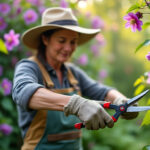This article provides an in-depth exploration of the most effective timing for pruning clematis, ensuring that these beautiful climbing plants thrive and produce impressive blooms in your garden.
- Understanding Clematis Pruning Groups
- Timing is Everything: When to Prune Clematis
- The Importance of Pruning for Healthy Growth
- Best Practices and Techniques for Pruning Clematis
- Frequently Asked Questions about Pruning Clematis
Understanding Clematis Pruning Groups
To successfully prune clematis, it is crucial to first categorize them according to their flowering habits. The pruning needs of these stunning climbers vary significantly based on when each type produces flowers. Generally, clematis can be divided into three main pruning groups: Group 1, Group 2, and Group 3. Recognizing these groups not only helps in the timing of pruning but also plays a significant role in promoting a healthy and vibrant display of flowers.
Group 1 – Early Bloomers: This group includes varieties that bloom in mid to late spring. Popular examples of Group 1 clematis include:
- Clematis alpina 🌱
- Clematis macropetala 🌼
- Clematis montana ⛰️
For these types, it’s essential to prune them immediately after flowering, as they bloom on last year’s wood. Pruning at this time ensures that next year’s blossoms are not sacrificed.
Group 2 – Large Flowering Clemmatis: This category is home to breathtaking hybrids often noted for their sizable blooms. Examples include:
- ‘Nelly Moser’ 🌸
- ‘The President’ 🌺
Group 2 clematis typically bloom in late spring or early summer and can be lightly pruned in early spring before new growth begins. This gentle approach encourages flowers to develop on both new and old wood.
Group 3 – Late Bloomers: These pulsating beauties burst into bloom in late summer and are characterized by flowering solely on new growth. They can be pruned back aggressively in early spring to promote a flourishing show in the upcoming warm months. Many late-summer bloomers belong here, ensuring a continuous display of colors well into autumn.
| Pruning Group | Blooming Time | Pruning Timing | Examples |
|---|---|---|---|
| Group 1 | Mid to Late Spring | After flowering | Clematis alpina, Clematis montana |
| Group 2 | Late Spring to Early Summer | Early Spring | ‘Nelly Moser’, ‘The President’ |
| Group 3 | Late Summer | Before growth starts in Spring | Various late-flowering varieties |
Timing is Everything: When to Prune Clematis
Understanding when to prune clematis is essential for ensuring their blooming success and maintaining vigorous growth. Each pruning group has distinct timing associated with them, allowing gardeners to optimize their clematis for the next flowering season.
Pruning Group 1: As mentioned, these clematis bloom in mid to late spring, and as soon as they have finished flowering, typically by the end of June, it is time to prune back any wilted flowers and tidy up the plant. This method allows the plant to prepare for another year of growth.
Pruning Group 2: For clematis in this group, the optimal pruning window is in early spring—late February to early March. This is when their growth hormones are starting to stir, making it an ideal time for a light trim. It helps in shaping the plant, promoting bushy and vigorous growth.
Pruning Group 3: These late bloomers require a more aggressive trimming. Pruning should be conducted in early spring, around February or March, ideally down to a foot or so from the ground. This harsh cut encourages the growth of new stems that will yield a dazzling display of flowers in the late summer.
| Pruning Group | Best Pruning Timing | Pruning Method |
|---|---|---|
| Group 1 | After mid to late spring flowering | Remove dead flowers, tidy plant |
| Group 2 | Late February to early March | Light trim for shaping |
| Group 3 | February or March | Cut back to about a foot |
The Importance of Pruning for Healthy Growth
Pruning clematis is more than just a cosmetic activity. It serves practical purposes, such as enhancing growth, improving air circulation, and helping prevent diseases caused by damp conditions. Regular pruning can lead to stronger plants and a more vibrant flower show year after year.
One of the primary benefits of pruning clematis is that it encourages fresh growth, which in turn supports greater flowering. A well-timed and executed pruning routine can lead to:
- Improved air circulation, which helps to prevent fungal infections 🌬️
- Increased sunlight exposure, encouraging blooming 🌞
- Enhanced overall plant health, leading to a more vigorous growth habit 🌱
Failing to prune can result in overcrowded plants, which not only hampers performance but also makes them susceptible to various pest issues with their dense foliage becoming an ideal breeding ground. Common pests attracted to unpruned clematis include aphids and spider mites. Proactive pruning, therefore, becomes a crucial strategy for both aesthetics and plant well-being.
| Benefit of Pruning | Impact on Plant |
|---|---|
| Encourages Fresh Growth | Leads to more flowers and a healthier plant |
| Improves Air Circulation | Reduces risk of fungal infections |
| Enhances Sunlight Exposure | Promotes vibrant blooming |
When to prune buddleia for optimal growth and flowering?
Best Practices and Techniques for Pruning Clematis
Efficiently pruning clematis plants requires a combination of knowledge, timing, and technique. Understanding the specific needs of each pruning group aids in providing the correct care for these beautiful climbing plants.
To ensure a successful pruning session, follow these best practices:
- Use sharp, clean pruning shears to avoid damaging the plant ✂️
- Familiarize yourself with the growth habit of your clematis group to tailor your approach 👩🌾
- Remove any dead, damaged, or diseased wood immediately, promoting better health 💪
- In Group 1, only perform light pruning; for Group 2, ensure you do not over-prune, and for Group 3, cut down to strong buds for optimal new growth 🌿
Additionally, it is beneficial to keep a pruning calendar or log, noting when each group was pruned. This offers a vital reference for future care and helps track the plant’s development effectively.
| Pruning Tips | Recommended Action |
|---|---|
| Use Clean Tools | Prevents disease spread |
| Familiarize with Growth | Enhances pruning success |
| Remove Dead/Damaged Wood | Improves plant health |
Frequently Asked Questions about Pruning Clematis
Understanding the nuances of pruning clematis can sometimes lead to questions. Here are some commonly asked questions and their answers:
- When is the best time to prune clematis?
The best time depends on the group. Group 1 clematis should be pruned after flowering, Group 2 in early spring before flowering, and Group 3 in early spring.
- Can I prune clematis in the fall?
While Group 3 can be lightly pruned, it’s generally best to prune in early spring for optimal growth.
- What happens if I prune at the wrong time?
Improper pruning timing can lead to reduced flowering or even a missed blooming cycle for the plant.
- Should I fertilize after pruning?
Yes, applying a balanced fertilizer after pruning promotes healthy growth and flowering.
- How much should I cut back my clematis?
Group 1 should only require deadheading, Group 2 a light trim, and Group 3 should be cut back to about 12 to 18 inches from the ground.
















